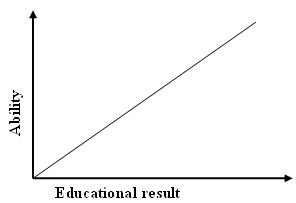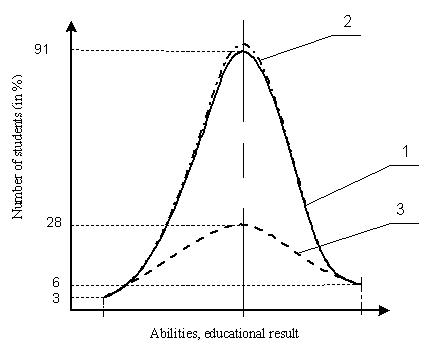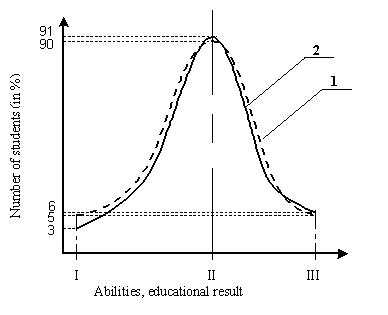Technology of educational process construction
The educational process technological construction is based on its designing proceeding from the set aims: educational reference points, purposes, teaching contents and social order.
The essence of the technological approach consists in that educational process guarantees achievement of the set objectives.
The technological approach to teaching provides:
- The precise formulation of the educational purposes with the orientation to achievement of the eventual result;
- Preparation of education materials and organization of all course of teaching according to the educational purposes;
- Evaluation of current results, the correction of teaching directed on achievement of the set objectives;
- Final evaluation of results.
Feature of the technological approach is that all students as participants of the common process should have identical result in knowledge mastering. For mastering by such technology it is necessary to consider in detail the features of educational material mastering in traditional educational process and in the educational process constructed on the technological approach.
As it is known the teaching purposes in the traditional approach are determined through the subject contents, process of activity of the student or teacher that does not give complete idea about the prospective results of teaching. In this case there is the significant predetermination of teaching results from the students abilities that is, in other words, the study score is determined by the abilities of students.
With the purpose of studying and confirmation of such dependence, researchers studied the similar regularity at pupils, as today's students are yesterday's pupils and the educational process is continuous from the 1st class up to institutes and academies.
The opinion of known teacher V.F.Shatalov concerning this question is of interest.
“The pedagogical science from the most different items tries to ensure the transition to the new contents of education. Physiologists, hygienists, methodologists, psychologists consider that all normal students can successfully acquire a program material in all subjects. How do matters stand actually? Can we tell quite frankly that we are ready to supply each graduate of school with deep, strong knowledge? Yesterday this question was answered in the affirmative from the highest tribunes. Today we trend more and more the opposite opinion, bashfully agreeing that even first-graders are started to divide on average, weak and strong, keeping for children such labels before leaving school. With the only one amendment: for years of study the group of strong pupils is washed away and the group of weak replenishes and grows. This sad statistics have the last time, as it was already marked, even the theorists - founders.
And this for all that not few but tens thousand teachers work in the country asserting and proving natural endowments of each healthy child, his opportunity programmed by the nature to acquire the most complex school programs in conditions of a favorable working conditions. A low level of knowledge of today's pupils is only consequence and the reason consists in imperfection of the obsolete teaching technique. All children - all without exception - are capable to master the program of high school successfully.” (V.F.Shatalov, 1998г.)
It is necessary to note that everything as for pupils in pedagogics questions concerns equally to students. It would be ridiculous and extremely unjustified to ignore the principles and approaches in technologies of teaching at school while constructing the students teaching process.
As a result of the research work consisting in determination of students’ progress on the eye illnesses faculty and their comprehensibility of educational material submitted in traditional educational process, i.e. without didactic bases and the technological approach one of categories of the educational purposes had been determined - a parameter of ability to understand the meaning of studied material. Certainly, theoretically it should make 100%. Actually there were 34%, i.e. only 34% of students understand the submitted material. During the research work we studied the most important category of the educational purpose – the ability to use the studied material in the practical activities, i.e. ability to apply the knowledge in specific conditions.
It turned out that only 28% of students could put into practice their knowledge at traditional system of teaching. At the same time it was registered the significant scattering of grades on the basis of the test control depending on abilities of either one or another students. In general, in traditional educational process the scattering of progress is determined by the disparity of abilities. It would be hypothetically possible to assume low efficiency of studies on this faculty but not to such extent. A subject of the further researches became a question - whether it is possible having changed the process of teaching to achieve high parameters on the output, i.e. on the final stage of teaching - during application of knowledge at liquidation of grades scattering. Thereby there was set a problem - to avoid such rectilinear dependence, to minimize dependence of success of teaching results on trainees’ abilities. Such difficult task required long studying and patent search of similar decisions. So in the researches of B. Blum and G. Carroll there was made an attempt to find out how results of teaching would be determined by the abilities of students if change conditions of teaching to which the study hours and data providing method, i.e. the form of a material giving concern. It is quite natural that the educational result is in direct dependence on the trainee’s ability and is displayed by the schedule.
 |
As is known, at any subject contents the distribution of students number according to the ability level is described by a so-called curve of normal distribution:
 |
1 - a curve of normal distribution according to the ability
2 - a curve of normal distribution by educational result
3 - a curve of actual educational result on the eye illnesses faculty at traditional educational process
|
Such conformity between students’ distribution according to the abilities and educational results level was confirmed by the data of experimental researches of B. Blum. Students with high abilities achieved good results, with average - average results and with low - low results. Abilities of students were measured before teaching. The factor of correlation between positive results and abilities was high enough - within the limits of 0,7. Hence, the degree of interdependence between students’ abilities and their results is high.
In an experimental research conducted by B. Blum and G. Carroll, in contrast to the traditional teaching, the conditions of educational process were optimized, first of all, the studying pace of educational material. G. Carroll stated the assumption of that the constant fixed parameter of educational process would be not temporary factors and information providing methods, but teaching result which should be achieved by each student. In that case all other parameters of educational process should vary and be adjusted to achievement of predetermined result by all students.
This approach has been advanced by B. Blum. He assumed that trainees abilities are determined by pace of material providing not at fixed average, but at optimally fitted conditions for each student. On basis of the received data on studying the abilities of students at studying of various subjects in conditions when time of studying is not limited, B. Blum determined the following categories of students:
- Having insufficient abilities - are not capable to achieve beforehand scheduled level of knowledge and skills even at the big duration of teaching (5%);
- Gifted - can study in high rate and acquire the information volume which the others cannot manage (5%);
- Usual students - the majority (90%), whose abilities for mastering knowledge and skills are determined by school hours expense.
These data have underlain the assumption that about 95% of students can acquire the contents of educational material completely under correct organization of teaching and especially at removal of temporary limits. In this case interdependence between abilities of students and results of teaching is considerably reduced and the corresponding factor of correlation approximates to zero.
Thus researchers determined that at the technological approach interdependence between abilities of students and the results achieved by them is considerably reduced. Practically everybody masters educational material and high results are achieved by students not only with high abilities but also with average and even below the average.
Results of our experiments were confirmed by mathematical conclusions of B. Blum and G. Carroll. So, studying abilities of students completed the cycle of “Eye illnesses” according to the new technology "KRYM•MED•DIDACTIC", we determined parameters of their abilities. The schedule illustrates the received data.
 |
I - a level of knowledge of students having insufficient abilities
II - a level of knowledge of average (usual) students
III - a level of knowledge of the gifted students
1 - The schedule in B. Blum and G. Carroll researches
2 - The schedule in researches of CSMU experimental group
|
The submitted material with efficiency of faculty of eye illnesses of amounting 28% and future trends of possible its finishing up to 91% has convincingly shown that it is possible to reach this level having changed conditions of teaching, i.e. having increased school hours or having changed the form of the information providing, having converted educational process to the technological basis. It is quite natural, that according to the curriculum of the higher medical school it is not possible to increase school hours. So the only one condition to increase the learning efficiency can be general introduction of new technological, didactic forms of teaching.
The comparative analysis of the traditional and technological approach to construction of educational process can be presented graphically as follows:
Thus one of basic positions of the technological approach consists in fixation of educational results on the high level which almost all students should achieve.
The technological approach to the process of teaching guarantees almost all students the achievement of high educational results.
Thus the designing of educational process is carried out as follows:
Distinctive feature of the technological approach to educational process is its orientation on achievement of fixed purpose and on same basis the correction of the educational process realized according to operative feedback. Thus operative feedback is the major moment of technological designing of the educational process providing all students (not only talented and gifted) an opportunity to achieve high educational rates.
The technological approach to the designing of educational process bases on a specific formulation of the educational purposes at the level of daily work of the teacher; determination of the fixed educational result which all students should achieve; the operative feedback, which allows to correct the process of formation of knowledge and skills. These components of educational process determine in its turn the process of monitoring in system "teacher - student".
The technological approach to educational process guarantees the achievement of set objectives of education. The operative feedback in the system of monitoring, penetrating all educational process, is the basis of consecutive orientation of education to the purposes. The purposes of teaching determine the success of educational process. Therefore their contents, the concrete formulation are the major step in technological designing of the educational process.
Studying either, one or another section of course, teacher usually makes it his aim to achieve that students understand, master its contents, receive the certain knowledge and learn to apply them.
[Contents]
|


